A systematic review of the prevalence of schizophrenia
- PMID: 15916472
- PMCID: PMC1140952
- DOI: 10.1371/journal.pmed.0020141
A systematic review of the prevalence of schizophrenia
Abstract
Background: Understanding the prevalence of schizophrenia has important implications for both health service planning and risk factor epidemiology. The aims of this review are to systematically identify and collate studies describing the prevalence of schizophrenia, to summarize the findings of these studies, and to explore selected factors that may influence prevalence estimates.
Methods and findings: Studies with original data related to the prevalence of schizophrenia (published 1965-2002) were identified via searching electronic databases, reviewing citations, and writing to authors. These studies were divided into "core" studies, "migrant" studies, and studies based on "other special groups." Between- and within-study filters were applied in order to identify discrete prevalence estimates. Cumulative plots of prevalence estimates were made and the distributions described when the underlying estimates were sorted according to prevalence type (point, period, lifetime, and lifetime morbid risk). Based on combined prevalence estimates, the influence of selected key variables was examined (sex, urbanicity, migrant status, country economic index, and study quality). A total of 1,721 prevalence estimates from 188 studies were identified. These estimates were drawn from 46 countries, and were based on an estimated 154,140 potentially overlapping prevalent cases. We identified 132 core studies, 15 migrant studies, and 41 studies based on other special groups. The median values per 1,000 persons (10%-90% quantiles) for the distributions for point, period, lifetime, and lifetime morbid risk were 4.6 (1.9-10.0), 3.3 (1.3-8.2), 4.0 (1.6-12.1), and 7.2 (3.1-27.1), respectively. Based on combined prevalence estimates, we found no significant difference (a) between males and females, or (b) between urban, rural, and mixed sites. The prevalence of schizophrenia in migrants was higher compared to native-born individuals: the migrant-to-native-born ratio median (10%-90% quantile) was 1.8 (0.9-6.4). When sites were grouped by economic status, prevalence estimates from "least developed" countries were significantly lower than those from both "emerging" and "developed" sites (p = 0.04). Studies that scored higher on a quality score had significantly higher prevalence estimates (p = 0.02).
Conclusions: There is a wealth of data about the prevalence of schizophrenia. These gradients, and the variability found in prevalence estimate distributions, can provide direction for future hypothesis-driven research.
Conflict of interest statement
Figures
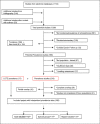
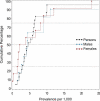

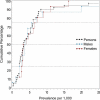
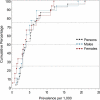
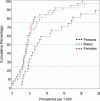
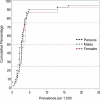
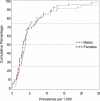



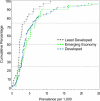
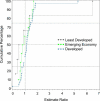
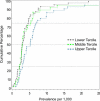
Comment in
-
The global prevalence of schizophrenia.PLoS Med. 2005 May;2(5):e151; quiz e175. doi: 10.1371/journal.pmed.0020151. Epub 2005 May 31. PLoS Med. 2005. PMID: 15916460 Free PMC article.
-
Secondary schizophrenia.PLoS Med. 2005 Sep;2(9):e279; author reply e300. doi: 10.1371/journal.pmed.0020279. Epub 2005 Sep 27. PLoS Med. 2005. PMID: 16173833 Free PMC article. No abstract available.
References
-
- Murray CJ, Lopez AD, editors. The global burden of disease: A comprehensive assessment of mortality and disability from diseases, injuries, and risk factors in 1990 and projected to 2020. Boston: Harvard School of Public Health; 1996. 990 pp.
-
- American Psychiatric Association. Diagnostic and statistical manual of mental disorders: DSM-IV, 4th ed. Washington (DC): American Psychiatric Association; 1994. 886 pp.
-
- Jablensky A. In: Schizophrenia: The epidemiological horizon. Hirsch SR, Weinberger DR, editors. Schizophrenia Oxford: Blackwell Science; 2003. pp. 203–231.
-
- Eaton WW. Epidemiology of schizophrenia. Epidemiol Rev. 1985;7:105–126. - PubMed
Publication types
MeSH terms
LinkOut - more resources
Full Text Sources
Medical

